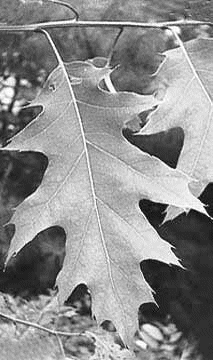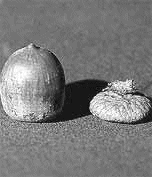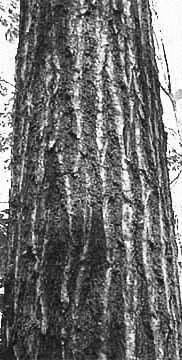Green Horizons
Volume 16, Number 1Winter 2011
Paige Pritchard, MU Center for Agroforestry
Northern red oak (Quercus rubra) is a large tree, with a straight, columnar trunk and large, spreading branches forming a round-topped crown. Like the white oak, it is widespread across eastern North America. The uses of red oak are numerous. Almost anything made of wood at one time or another has been made from northern red oak; furniture, veneer, molding and trim, flooring, railroad ties, farm lumber, even pallets and crating. Its pleasant, uniform color and grainy texture make it an excellent wood for home workshops. Like the white oak, red oak acorns are an important food for many kinds of wildlife.
Like all oaks, the leaves are alternately arranged on the twig. Northern red oak leaves are simple, 5 to 8 inches long, roughly egg-shaped in outline with the broadest part above the middle; with 7 to 11 upward-pointing, bristletipped lobes. The sinuses (indentations between the lobes) typically extend half-way down to the central leaf vein. The upper leaf surface is smooth and yellow-green and the lower surface is somewhat paler in color and smooth except for occasional tufts of hair in the intersections of the veins. The fruit is an acorn, one inch long, somewhat hairy at the cup end. The acorn cup is saucer-shaped, enclosing about ¬ of the nut; cup scales are numerous and not warty. One telltale trait for northern red oak is the broad, smooth ridges of bark extending great lengths down the trunk. Some say they resemble tracks made by snow skiers.
 |
| A northern red oak leaf is 5 to 8 inches long, with 7 to 11 upward-pointing, bristletipped lobes. The sinuses typically extend half-way down to the central leaf vein. |
Northern red oak grows in soils ranging from clay to loamy sands, and from deep, stone-free to shallow, rocky soils. The species is most frequently found on northerly and easterly aspects, lower and middle slopes, coves and ravines, and valley floors. Aspect and position on the slope are important factors affecting red oak site quality. The best sites are characterized by the presence of fine-textured soil and topography that favors a high water table.
The major tree associates of northern red oak in Missouri include white, black, and chinkapin oak; white and green ash; sugar maple; black cherry; shagbark and mockernut hickory; American basswood; sycamore; cottonwood; black walnut; and hackberry. Some of the more important understory associates are flowering dogwood, pawpaw, hornbeam, hophornbeam, redbud, and serviceberry.
 |
| A northern red oak acorn is about one inch long, somewhat hairy at the cup end. The acorn cup is saucer-shaped, enclosing about ¼ of the nut; cup scales numerous and not warty. |
Northern red oak begins to bear acorns when about 25 years old. Good seed crops are produced every two to five years.As with white oak, there is great variation in acorn production among individual trees within stands and from year to year. Unlike white oak, acorns take two years to mature and germinate in the spring after seed fall.
 |
| One tell-tale trait for northern red oak is the broad, smooth ridges of bark extending great lengths down the trunk. Some say they resemble tracks made by snow skiers. |
Small white oak trees sprout prolifically and vigorously when cut or damaged by fire. Northern red oak stump sprouts are subject to decay from the parent stump, especially if they originate high on the stump. Sprouts arising at or below ground level will be the least likely to decay. Northern red oak is classed as intermediate in tolerance to shade. Among the oaks, it appears to be less tolerant than white oak but more tolerant than black or scarlet oak. The species responds well to crop tree release.
The principal threat to northern red oak is the oak wilt fungal disease. Usually it kills individuals or small groups of trees in scattered locations throughout a stand. The fungus can be passed tree-to-tree by way of root grafts, or fungal spores can be carried greater distances by sap-feeding insects or on the blades of pruning saws and shears. Because of this latter pathway, northern red oak (and actually all oaks) should not be pruned during the growing season.
Tree Identification References Trees of Missouri Field Guide by Don Kurz.Missouri Department of Conservation. $7.50 www.mdcnatureshop.com Trees of Missouri by Carl Settergren and R. E. McDermott.University of Missouri Extension Publication SB-767. $8.00 www.extension.missouri.edu/publications A Key to Missouri Tree in Winter by Jerry Cliburn and Ginny Wallace. $3.00 www.mdcnatureshop.com |